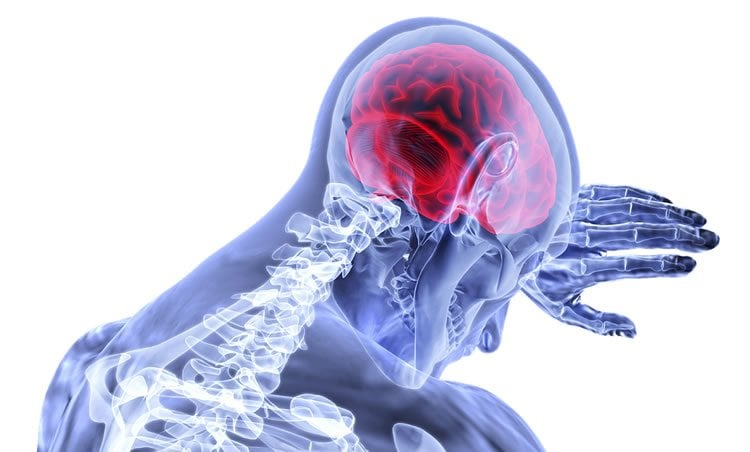Summary: Is the popular claim that the brain feels no pain substantiated? A new paper looks at the accuracy of the belief.
Source: The Conversation.
The brain has no nociceptors – the nerves that detect damage or threat of damage to our body and signal this to the spinal cord and brain. This has led to the belief that the brain feels no pain. A belief that has entered popular culture.
In the 2001 movie Hannibal, there is a gut-twisting scene in which the eponymous Hannibal Lecter cuts out part of the brain of an FBI agent who is fully awake, though drugged, and seated at a dinner table.
“See the brain itself feels no pain,” Lecter tells an aghast Clarice Starling.
But if the brain feels no pain, what causes headaches?
Although the brain has no nociceptors, many of the other structures in our head do, including blood vessels, muscles, and nerves in the neck, face and scalp. Headaches are caused by problems with these structures.
Different types of nociceptors are activated by pressure, damage, extremes of temperature and some chemicals, such as capsaicin (the active ingredient in chilli peppers).
“Brain freeze” or “ice-cream headaches” seem to be caused by sudden changes in blood flow in the veins that lie between the back of the throat and the brain. Dehydration causes headaches by irritating the blood vessels in the head and is one reason for the throbbing head that many experience after a night of drinking. And any dentist can tell you that a headache could indicate you over-exert your jaw, perhaps by grinding your teeth when you sleep.
The cause of pain during migraine is still not well understood but is thought to be the activation of nociceptors in the meninges – the cellophane-like wrapping that encases the brain and spinal cord. What might cause this activation, though, is still unclear.
Even though the brain has no nociceptors, a headache can still signal a problem with the brain. Headaches that are prolonged and don’t respond to drugs, or that are sudden and extraordinarily severe, can be signs of a serious problem with the brain, such as a tumour, bleeding or infection. Although these problems cause pain, it is not by activating nociceptors in the brain itself – because it doesn’t have any – but because the brain swells and puts pressure on other structures in the head.
More than just a sensory experience
In a fundamental sense, Hannibal Lecter was wrong about the brain feeling no pain. Although the brain has no nociceptors, the brain “feels” all our pain. This is because our brain is the organ through which we interpret, evaluate and experience all the sensory signals from our body.
Scientists distinguish between nociception – the nervous signal of damage to our body – and pain, the unpleasant emotional and cognitive experience that normally results when our nociceptors are activated.
This means that pain is more than just a sensory experience, it is influenced by our thoughts, feelings and social relationships. For example, how we experience pain is affected by our thoughts, such as what we believe the pain might mean, and what we remember of previous painful experiences.

Pain is also an emotional experience: people with depression report that they experience more pain in daily life. And inducing a low mood in otherwise normal people increases pain ratings and lowers tolerance to pain.
It is also a social experience. In one experiment, students who were asked to hold their hand in painfully cold water for as long as possible tolerated the pain for longer if they thought the experimenter was one of their professors than if they thought the experimenter was a fellow student. This shows that who asks us about our pain is important.
The social influences on pain also show the benefits of having support from those who care about you. In another study that used the same ice bucket method, people had a greater tolerance for the painful cold when another person silently observed the experiment, compared with being alone with the experimenter. And if the “observer” was a friend of the same sex, the participants had higher tolerance even if the friend was not actually inside the room, but was merely nearby.
Given the many influences on how we experience pain, it is no wonder that finding relief from pain can be complex and frustrating. The good news is, each of these influences also represents a way to manage pain. Helping people change their thoughts and feelings about their pain are important parts of pain management, as is maintaining social relationships.
University of Bath are looking for volunteers to take part in research investigating body perception in chronic pain.
Source: Janet Bultitude – The Conversation
Publisher: Organized by NeuroscienceNews.com.
Image Source: NeuroscienceNews.com image is in the public domain.
[cbtabs][cbtab title=”MLA”]The Conversation”Does the Brain Really Feel No Pain?.” NeuroscienceNews. NeuroscienceNews, 6 September 2018.
<https://neurosciencenews.com/brain-pain-9812/>.[/cbtab][cbtab title=”APA”]The Conversation(2018, September 6). Does the Brain Really Feel No Pain?. NeuroscienceNews. Retrieved September 6, 2018 from https://neurosciencenews.com/brain-pain-9812/[/cbtab][cbtab title=”Chicago”]The Conversation”Does the Brain Really Feel No Pain?.” https://neurosciencenews.com/brain-pain-9812/ (accessed September 6, 2018).[/cbtab][/cbtabs]






